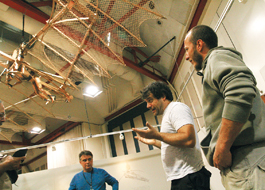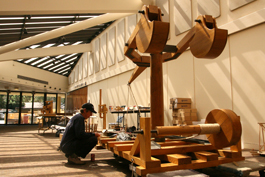home | metro silicon valley index | the arts | visual arts | review

WINGED VICTORY?: David Whitman (from left), the Tech's special projects manager, and master artisans Massimiliano Di Cocco and Tomasso Cannavale speculate about da Vinci's flying machine.
Modeling The Master
The Tech Museum explores the mind and world of da Vinci in 'Leonardo: 500 Years Into the Future'
By Michael S. Gant
Photographs by Felipe Buitrago
EVEN AS a scale model of about 6 feet in height, the rock-slinging siege engine known as the trebuchet looks like it could do some serious damage to the walls of San Jose's Tech Museum. The original design by the 15th-century Sienese engineer Mariano Taccola called for a weapon at least 50 feet high—a formidable sight outside the walls of a surrounded city.
This wonderful working machine, re-created from manuscript sketches by Taccola, is fashioned using traditional wood and metal materials. It functions as both a 3-D educational tool and a sculpture of great beauty, a physical glimpse into the creative spirit of the Renaissance. The trebuchet is one of scores of working models that can be seen in the Tech's fall presentation, "Leonardo: 500 Years Into the Future."
The models, commissioned by the history of science museum in Florence, form the core of the exhibit. On the day I previewed "Leonardo," much work remained to be done by Italian artisans brought over to assemble the show. We had to sidestep plywood-toting workmen and shout to be heard over the high-pitched whir of electric drills.

Leonard da Vinci, the exemplar of Renaissance genius, gives the museum a marquee name, but one of the points of the exhibit is that the protean inventor and painter didn't work in a vacuum. His remarkably prescient ideas arose from the cultural and scientific ferment of the age. Taccola, for instance, was one of the many artist engineers working in Siena in the 1400s, developing mechanical solutions to advance public works projects. One of the most impressive models demonstrates how marble columns were slowly levered from the horizontal to the vertical. Thanks to the marvels of toothed wheels and pinion gears, one man turning a single handle could raise a great weight.
Again and again, these elegantly simple combinations of wheels turning wheels were employed to move water, dredge mud, lift the building blocks for cathedrals. Nearly impossible results could be achieved from a progression of mechanical advantages, hence Filippo Brunelleschi's dome for the Florentine church Santa Maria del Fiore. A magnificent 1/20th scale model of the dome dominates one room of the exhibit. Peer inside one of the cut-away sections and it is possible to see the intricate layered construction method.
The most startling creation is Leonardo's flying machine, hung from the ceiling. A framework of wooden ribs replicate the delicate bone structure of a bird's wings. An articulated wooden man controls a symphony of gears, pulleys and cranks. The ambition is breathtaking, even if the prospect of it actually working seems an impossible dream. Did da Vinci ever give this big bird a test flight? Two of the Italian artisans on-site—Tommaso Cannavale and Massimiliano Di Cocco, working to overcome a bit of a language barrier—explain that Leonardo did some experiments with the machine "but he didn't try it himself; someone else did it." We know this because "he [Leonardo] didn't die," says Massimiliano with a laugh.

In addition to the large models, the show invites visitors to test Leonardo's mechanical ideas by operating hands-on versions. Other displays will demonstrate some of da Vinci's optical experiments and anatomical studies. One of the latter is a wall-size bas relief of a man sprouting claws and lifting his arm to spread a dragon's leathery wing. "Batman," suggests Massimiliano.
Both outside and in, the show is presided over by the Sforza horse, a 24-foot-high realization in fiberglass of the grand bronze sculpture that da Vinci worked on for many years but never completed. An intricate model shows how da Vinci planned for a huge furnace next to a pit in which the enormous mold was suspended from ropes and pulleys mounted on a scaffolding waiting for the flow of molten metal. Eventually, the 70-plus tons of bronze required were considered too valuable for art and were melted down to make cannons instead. Even a genius like Leonardo couldn't overcome bellicose imperative.
LEONARDO: 500 YEARS INTO THE FUTURE runs Sept. 27–Jan. 4 at the Tech Museum, 201 S. Market St., San Jose. Open Thursday–Sunday, 9am–8pm, and Monday–Wednesday, 9am–5pm. Tickets are $15–$25. (408.294.TECH).
Send a letter to the editor about this story.
|
|
|
|
|
|